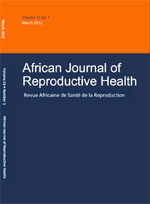
|
African Journal of Reproductive Health
Women's Health and Action Research Centre
ISSN: 1118-4841
Vol. 22, No. 2, 2018, pp. 68-75
|
 Bioline Code: rh18024
Bioline Code: rh18024
Full paper language: English
Document type: Research Article
Document available free of charge
|
|
|
African Journal of Reproductive Health, Vol. 22, No. 2, 2018, pp. 68-75
| fr |
Ishaku, Salisu M; Diop, Nafissatou; Mané, Babacar; Liambila, Wilson; RamaRao, Saumya; Clark, Heather; Birungi, Harriet; Unumeri, Godwin & Obare, Francis
Résumé
L'anneau vaginal de progestérone (AVP) est un dispositif en forme d'anneau conçu pour être utilisé par les femmes pendant la période postpartum pour réguler la fertilité en complétant et en augmentant l'efficacité contraceptive de l'aménorrhée lactationnelle pour supprimer l'ovulation1. Il est disponible dans huit pays d'Amérique latine Les AVP sont une méthode qui peut convenir aux femmes en Afrique subsaharienne, étant donné la pratique quasi universelle de l'allaitement maternel et le niveau actuel du besoin non satisfait de contraception pendant la période post-partum. Des efforts sont actuellement déployés pour introduire le RVP en Afrique et en Asie du Sud. Pour assurer une introduction, une mise à l'échelle et une pérennité du RVP dans la région, le Population Council a mené des activités de pré-introduction avec des parties prenantes au Kenya, au Nigeria et au Sénégal pour déterminer le niveau d'intérêt des solutions pour relever les défis. L'équipe de recherche a combiné trois approches: des entretiens approfondis avec les parties prenantes de la planification familiale; examen documentaire des rapports et des lignes directrices; et réunions en groupe. Les parties prenantes touchées comprenaient des responsables du secteur public, notamment des décideurs et des responsables de programmes, des partenaires d'exécution, des régulateurs, des femmes et des réseaux religieux. Les trois pays avaient un contexte politique et programmatique prometteur qui était favorable à l'introduction du RVP. L'exercice a permis de mieux comprendre les facteurs socioculturels et religieux susceptibles d'avoir une incidence sur la façon dont le RVP est perçu au sein des collectivités et d'identifier les solutions possibles pour corriger les perceptions erronées. Il a également ouvert la voie à la réalisation d'une étude d'acceptabilité du PVR chez les femmes allaitantes dans ces pays. Le taux élevé d'acceptabilité dans chaque pays et le soutien exprimé par le gouvernement et d'autres parties prenantes ont stimulé l'enregistrement du produit dans chaque pays. L'apprentissage de ce processus pourrait également indiquer comment d'autres produits de planification familiale et de santé reproductive seront introduits à l'avenir. (Afr J Reprod Health 2018; 22[2]:68-75).
Mots Clés
Anneau vaginal de progestérone; planification familiale post-partum; Afrique subsaharienne
|
| |
| en |
Introducing the Progesterone Vaginal Ring (PVR) as a New Option for Postpartum Family Planning in Sub-Saharan Africa: Insights from Engagements with Stakeholders
Ishaku, Salisu M; Diop, Nafissatou; Mané, Babacar; Liambila, Wilson; RamaRao, Saumya; Clark, Heather; Birungi, Harriet; Unumeri, Godwin & Obare, Francis
Abstract
The progesterone vaginal ring (PVR) is a ring-shaped device designed for use by women in the postpartum period to regulate fertility by complementing and extending the contraceptive effectiveness of lactational amenorrhea to suppress ovulation.1 It is available in eight Latin American countries for use by breastfeeding women who want more effective modern contraceptives in addition to contraceptive benefits provided by lactational amenorrhea alone.1 The PVR is a method that can be suitable to women in sub-Saharan Africa, given the near-universal practice of breastfeeding and the current level of unmet need for contraception in the postpartum period. Efforts are currently underway to introduce the PVR in Africa and south Asia. To ensure a seamless introduction, scale up and sustainability of the PVR in the region, the Population Council conducted pre-introductory activities with stakeholders in Kenya, Nigeria and Senegal to determine the level of interest in the ring, potential facilitating and mitigating factors and identify solutions to address challenges. The research team combined three approaches: in-depth interviews with family planning stakeholders; desk review of reports and policy guidelines; and in-group meetings. The stakeholders reached included public sector officials including policy makers and program managers, implementing partners, regulators, women and religious networks. All three countries had a promising policy and programmatic context that was supportive to PVR introduction. The exercise provided insights on socio-cultural and religious factors that could potentially impact how the PVR is perceived within communities and identified possible remedies to address misperceptions. It also paved the way for the conduct of an acceptability study of the PVR among breastfeeding women in these countries. The high acceptability rate in each country and the support expressed by government and other stakeholders have provided impetus for registration of the product in each country. Learning from this process could also direct how other family planning and reproductive health commodities would be introduced in the future. (Afr J Reprod Health 2018; 22[2]:68-75).
Keywords
Progesterone Vaginal Ring; postpartum family planning; sub-Saharan Africa
|
| |
© Copyright 2018 - African Journal of Reproductive Health
Alternative site location: http://www.ajrh.info
|
|
